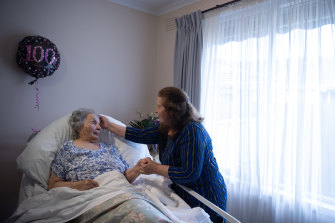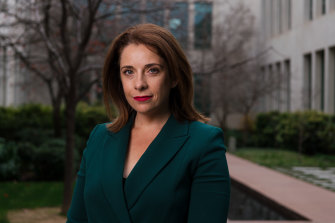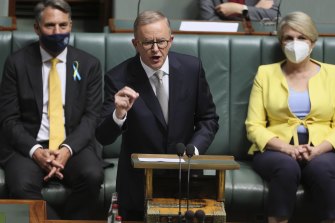Key points
- An average of 11 residents have died each day with COVID in aged care this year.
- The new aged care minister Anika Wells says homes are “grossly understaffed”.
- More older people are staying out of aged care longer, making homes less viable.
- Some children are taking their parent out of aged care to care for them at home.
COVID-related deaths in Australian aged care homes are now averaging 11 people each day, as families increasingly shun the sector and a new federal minister faces the task of fulfilling Labor’s promise to tackle the crisis swiftly.
In the first five months of this year alone, there have been 1572 deaths caused by COVID-19 in nursing homes, compared to 231 for the whole of last year. There are 780 COVID-19 outbreaks in the nation’s 2650 nursing homes.
Maria Sampey has brought her mother, Vittoria, home from an aged care facility to care for her herself.Credit:Simon Schluter
Families are increasingly opting to keep elderly relatives at home or remove them from aged care.
Newly sworn-in Aged Care Minister Anika Wells said fixing aged care was one of the issues that contributed to Labor’s election victory. “Tens of thousands, if not more, Australians voted for us on the basis that they were putting their faith in us to help people in aged care.”
The situation has dramatically slowed the number of older people entering care and led some families to withdraw family members to care for them at home.
Among them is Maria Sampey, who withdrew her mother, Vittoria Primerano, from an aged care facility to care for her herself at her Dandenong North home. “I couldn’t fathom the treatment of my mother being isolated in her room,” said Sampey, who is a former local government councillor.
Aged Care Minister Anika Wells says the new government has a mandate to improve the aged care sector. Credit:James Brickwood
She found it difficult to visit Primerano, who has dementia and can’t walk or talk, during the pandemic-induced lockdowns. “It made it impossible to check she was being cared for.”
And so she took her mother out, “to let her die at home with dignity and [to] know she’s been fed and hydrated – because that’s not what was happening”.
Primerano turned 100 last month. “She wouldn’t have made it to 100 if I’d left her in care,” said Sampey.
Sampey gets support at home under the federally funded home-care system, but agencies providing staff for this program are warning they face unprecedented demand for nurses.
“We would be happy to hire another 400 home-care workers tomorrow because the need at the moment far exceeds the workforce,” said Sarah Newman, general manager of home services at BaptistCare NSW & ACT.
Older people now wanted to go into residential care only when “they have high-level clinical needs that really can’t be managed by a carer at home, or they’ve got dementia and it just isn’t safe”.
“Isn’t it a good thing that we’re able to keep people at home where they want to be and in part of their community? At the right point where they really aren’t coping, that’s when residential care is appropriate.”
Nursing home operators are also warning that, with fewer residents, the viability of some facilities is in doubt, and that the new Albanese government must swiftly provide stop-gap funding until a major staff wage case before the Fair Work Commission is settled.
On Wednesday, Wells told the ABC’s Patricia Karvelas she would immediately get to work on a promised pay submission to the FWC. Before it was elected, Labor said it would support a union application for nurses, carers, cooks and others in aged care to get a 25 per cent pay rise.
Operators fear that, if the FWC case is successful, more funding will be needed to meet a higher wages bill. If it is not found, it could lead to a further reduction in staffing levels.
So severe is the drop in people entering homes that most are now running at a financial loss as the growing home-care sector poaches workers, also putting new minimum staffing standards promised by Labor at risk. A University of Technology Sydney study last month found two-thirds of 1192 aged care homes surveyed were running at a loss, up from 52 per cent last year.
Darren Nelson runs equipment rental company Solace Sleep, which has seen electric, adjustable bed sales soar. “From the time the pandemic started, it’s been absolutely a monumental shift in the percentage of sales in this area. People just didn’t want to be in an environment where COVID was and where aged care homes are being locked down.”
“People are renovating houses or putting on granny flats, bringing their parents home to be looked after, which I would say is different for the Australian culture – but it’s a good different.”
Prime Minister Anthony Albanese has supported a wage increase for aged care staff.Credit:Alex Ellinghausen
Labor promised in the lead-up to the election to tackle the aged care crisis swiftly if it won office. Anthony Albanese pledged to inject $2.5 billion into the sector and made five key promises: backing the FWC wage case, getting a registered nurse on-site at all times in every nursing home, 215 minutes per resident of mandatory daily care, mandatory nutrition standards to improve food, and greater transparency on how homes spend public funding.
Paul Sadler is chief executive of Aged and Community Services Australia, which represents not-for-profit aged care homes. He said COVID-19 lockdowns and restrictions on relatives visiting had a huge impact on older people delaying entering aged care homes.
“People are still going into aged care because that’s absolutely the best place for their needs to be met – families often can’t do it without having people in 24/7 care at times,” he said. “But particularly through the pandemic, people are really delaying till the last possible moment coming into aged care.”
Sadler said aged care homes needed a new financial supplement to increase staff wages immediately so they didn’t have to await the outcome of the FWC case brought by nursing and carer unions.
He said while it was good more people were staying home for longer, “this has put pressure on the viability of aged care homes”.
Vittoria Primerano moved into aged care a decade ago, after the great-grandmother of eight started showing signs of dementia. Sampey said the care she received once COVID-19 arrived was not good. “The staff are run off their feet, and they haven’t got the time to care for people.”
She said it had been hard work caring at home for her mother, who moved from Italy to Australia in 1956 from a small Calabrian town.
Caring for her mother has been worth it, though, Sampey said.
“You haven’t got that knot in your stomach as you’re approaching the nursing home, thinking, ‘What state am I going to see my mother in?’”
“I know that my mother now is asleep, that she’s going to wake up at about 1pm, that I’ve got vitamised food for her – today, I’ve made chicken cacciatore and vegetables.”
Most Viewed in Politics
From our partners
Source: Read Full Article





